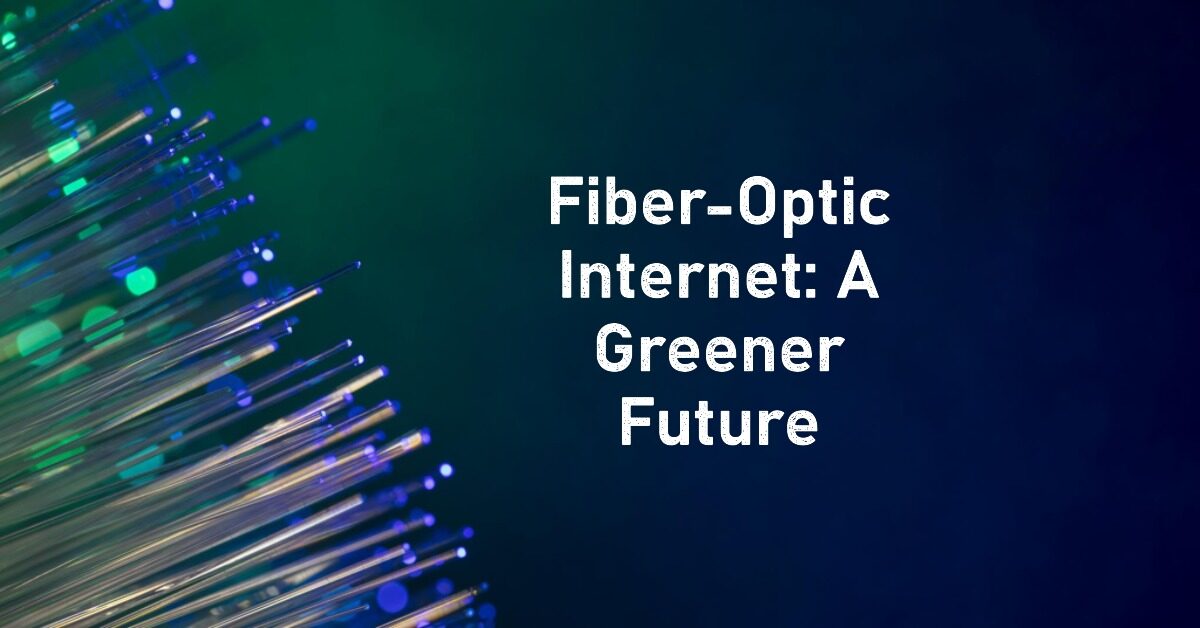For homes and companies looking to enjoy high-speed internet while lowering their carbon footprint, fiber Internet is a great option. Its sustainability benefits are diverse and impactful.
Fiber Internet is first and foremost environmentally beneficial. Compared to other cable options, it is manufactured with fewer resources and less energy. This results in a smaller environmental impact from the beginning of production.
Also, fiber optic internet has the ability to have a positive influence on society and the environment on a larger scale. We have seen hints of these advantages during the past year. For instance, it encourages telecommuting and online meetings, which can cut down on the need for long-distance travel and the emissions of greenhouse gases.
Fiber Utilises Eco-Friendly Materials
Traditional internet cables transport electrical impulses using copper lines, which has a negative impact on the environment. Copper mining can have a negative impact on groundwater, biodiversity, waste production, and carbon footprint, whereas fiber optic cables are made of glass and use light beams to convey data. The primary component, silica (silicon dioxide), is widely distributed in sand and is readily available in the Earth’s core.
Although there is still some environmental impact during the production of fiber cables, it is much less than during copper extraction. In fact, lowering the amount of metals like copper that are extracted is essential for minimising global warming. Fortunately, there is no need to reduce fiber production because it offers a more environmentally friendly option for high-speed internet connectivity.
A Smart Energy-Saving Option
While running at 50 Mbps, fiber connections emit only 1.7 tonnes of CO2 yearly, compared to 2.7 tonnes for the best copper substitute. You can immediately reduce your annual carbon emissions by a significant 1 tonne by switching to fiber.
This astounding energy efficiency is not just available at 50 Mbps speeds. The potential CO2 savings from fiber are much larger now that faster choices like gigabit services are accessible. In large part, this is due to the fact that fiber cables can carry data over considerably greater distances without the requirement of intermediary components like amplifiers. These appliances require cooling and use electricity, both of which increase emissions.
Additionally, a fiber broadband connection can reduce the amount of electricity used in your house. Large files may be downloaded quickly thanks to the high speed internet, and it uses less power to transmit the broadband signal. Fiber is therefore not only incredibly fast, but it also saves energy and is environmentally beneficial.
Long-Lasting and Low-Maintenance Fiber Optic Technology
Because of its outstanding endurance, fiber optic technology offers a twin advantage in terms of cost-effectiveness and environmental friendliness. Fiber optics require less maintenance and upgrading since they are less subject to weather-related outages than cable, DSL, or satellite. Repair times for fiber networks are 67% faster than those for cable or DSL, even in network outages.
The virtually unlimited bandwidth capacity of fiber optics eliminates the need for frequent updates. Fiber optic internet providers near you can run a fiber network for up to 25 years without the need for significant improvements, in contrast to other internet technologies. Fiber optics are environmentally friendly and cost-effective due to their remarkably long lifespan and high bandwidth capacity, which lowers both the carbon footprint and the costs of network upkeep and upgrades.
Built to Last and Adapt
Fiber optics are built to last and give a solution that is significantly superior to the gigabit speeds offered by the existing internet providers. As 10 Gbps broadband becomes the standard, the fiber cables that are already installed in houses can easily manage these extremely fast rates. Additionally, fiber cables are designed to last for decades and exhibit improved resistance during extreme weather conditions. Fiber networks, in contrast to conventional copper cables, can be upgraded without changing the wires themselves, assuring that they will last.
This minimal long-term impact means that once fiber networks are installed, they remain in place, which requires only routine maintenance without the need for complete cable replacements. For high-speed internet, fiber optics offer a reliable, adaptable, and affordable option that can keep up with the constantly changing demands of the digital era.
The Ripple Effects of Fiber Optic Internet
It’s crucial to know that fiber optic internet has environmental benefits beyond those that are immediately apparent. There are many possible second-order, indirect benefits, including:
Reduced Plastic Use: Copper cables cannot transfer as much data as fiber optic cables, which can do so without using as much plastic-based cladding material. This decreased reliance on resources derived from oil promotes a more sustainable strategy.
Less Copper Dependency: The lower demand for copper in fiber optic networks results in fewer mining operations, which has a negative impact on the environment.
Environmental and Social Impacts of Fiber-Optic Internet
The fast and dependable fiber-optic internet has advantages for the environment as well as societal challenges.
Resource Efficiency: Fiber-optic internet is more resource-efficient than previous broadband technologies, which means that metals like copper and aluminium aren’t as frequently needed. It still has some environmental expenses, such as the disposal of old cables and the extraction of silica for glass fibers.
Digital Inclusion: Fiber-optic internet, particularly in rural regions, can close the access gap and reduce the digital divide. However, inclusion attempts might be hampered by up-front installation costs, provider competitive difficulties, and the requirement for digital literacy.
Enhancing Innovation: Fiber-optic internet fosters creativity and productivity across a range of industries, making innovations like cloud computing and AI possible. Additionally, it improves already-existing applications like e-commerce and video conferencing. It may have a good effect on economic growth, according to reports.
Get Fiber Internet Today
Fiber provides the potential for a more ecologically friendly internet in addition to being the future of the internet. Fiber optic networks are essential for reducing the ecological impact of internet connectivity, both directly and indirectly.
